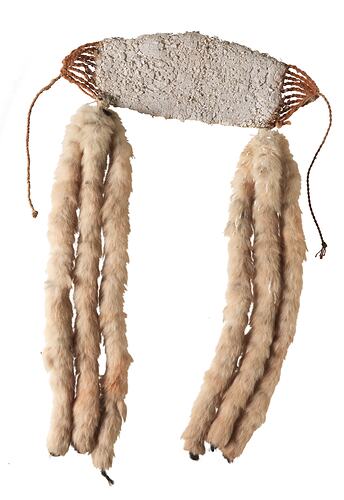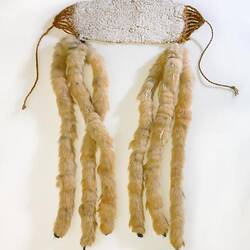Summary
This headband was collected by the ethnographer George Horne in 1921 from Mungerainie Bore, a small settlement east of Lake Eyre in South Australia. This remote area is home to the Wangkanguru people who made these headbands or charpoo. According to Horne, the headband was used in a welcoming ceremony known as the mindiri that is performed by a large group of men near Mungerainie. As was customary, whenever one group of men travelled to another's country, their visit had to be sanctioned through a special ceremony conducted by both the hosts and visitors. In this way, any outstanding conflicts that existed between the groups could be absolved ritually while the visitors remained on foreign soil. Moreover, the welcoming ceremony gave the visitors the authority to use local water and food supplies during their stay. These ceremonies often involved the re-telling of dreaming stories through the use of body decorations and dance movements. The welcoming ceremony in which the headband was used concerned an emu ancestor, muramura warugati, and described his travels across Wangkanguru country. By wearing the headdresses and performing the ceremony, the Wangkanguru men could not only demonstrate that they were the ritual owners of the emu story, but the owners of the land from which the story emanated. Thus, the visitors would be obliged to accept the authority of the Wangkanguru men in welcoming them into their country.
The use of rabbit tails to adorn this headband is evidence of the penetration of this introduced animal into the arid regions of the continent by the turn of the twentieth century.
Local Name
Charpoo
Physical Description
A headband made from vegetable fibre string painted with white pipe clay. The tassels attached at the ends are made of rabbit tails.
More Information
-
Object/Medium
Ornament, head
-
Maker
-
Cultural Groups
-
Locality
-
Date Produced
-
Collector
-
Date Collected
-
Object Measurements
700 mm (Length), 560 mm (Width), 50 mm (Height)
-
Classification
-
Date Made
-
Maker
-
Clan/Language Group
-
Place Made
-
Indigenous Region
-
Keywords
-
Acquisition Information
Donation from Dr George Horne, 02 Aug 1922
-
Collection Names
-
Type of item
-
Discipline
-
Category
-
Collecting Areas


